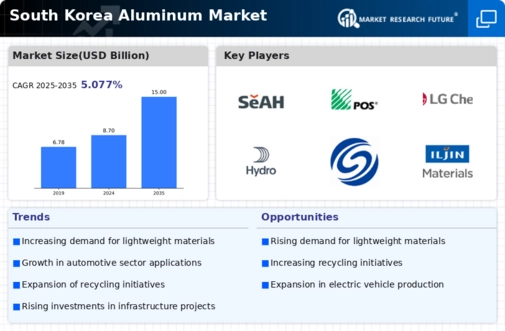The South Korea Aluminum Market is characterized by a unique blend of competitive elements that shape its growth and development. With the increasing demand for aluminum across various sectors, such as automotive, construction, and electronics, the market is becoming more competitive and innovative. South Korea's aluminum industry benefits from advanced manufacturing technologies, robust supply chains, and a strong research and development base, which enhances the market's competitive dynamics. Companies within this market are focusing on leveraging technological advancements and sustainable practices to improve product efficiency and reduce environmental impact.
The increasing emphasis on lightweight materials, coupled with government policies aimed at promoting the use of aluminum, further intensifies competitive pressures among industry players.Hanwha Corporation stands out in the South Korea Aluminum Market with its strong market presence and significant contributions to the sector. The company is recognized for its capabilities in producing high-quality aluminum products, catering to various applications including construction and automotive industries. Hanwha Corporation leverages its vast resources and technological expertise to enhance its production processes and ensure the delivery of innovative aluminum solutions that meet client demands.
Additionally, the company benefits from a diversified portfolio, allowing it to tap into multiple market segments effectively. By prioritizing sustainability and efficiency in manufacturing, Hanwha Corporation strengthens its competitive position and continues to thrive within the South Korean aluminum landscape.SeAH Steel plays a prominent role in the South Korea Aluminum Market, focusing on the production and supply of aluminum products essential for diverse applications. The company offers a range of solutions, including aluminum sheets and extrusions, which are foundational components for sectors such as construction, transportation, and consumer electronics.
SeAH Steel’s market presence is reinforced by its commitment to quality, innovation, and customer satisfaction, enabling it to forge long-term partnerships within the industry. The company continually invests in research and development to advance its product offerings and production methods. In addition, strategic mergers and acquisitions have bolstered SeAH Steel's position, allowing it to expand its capabilities and enhance operational efficiencies, thereby solidifying its strengths in the competitive South Korean aluminum market.


















Leave a Comment